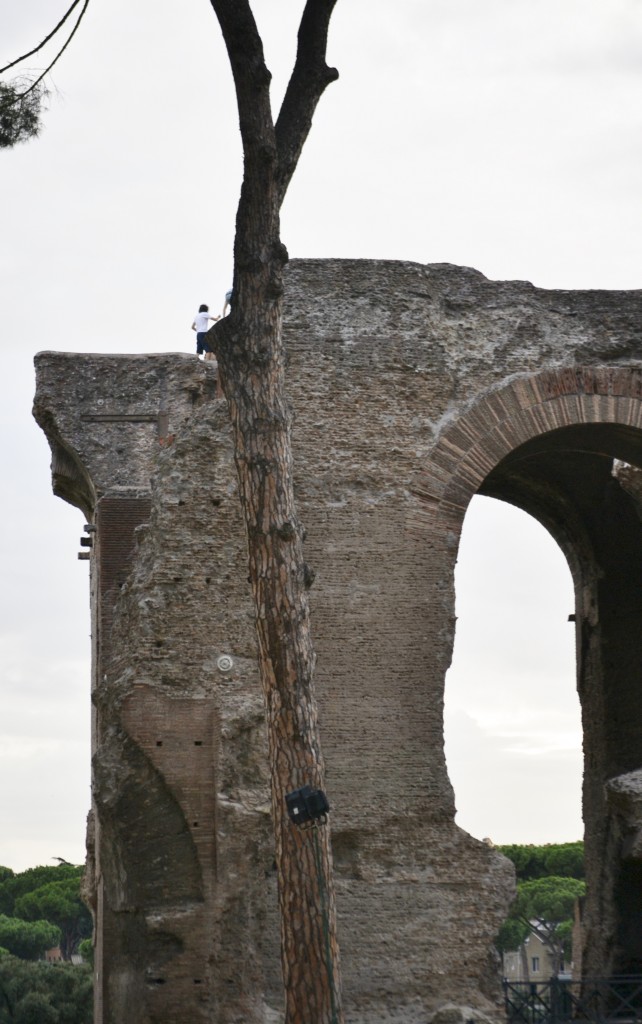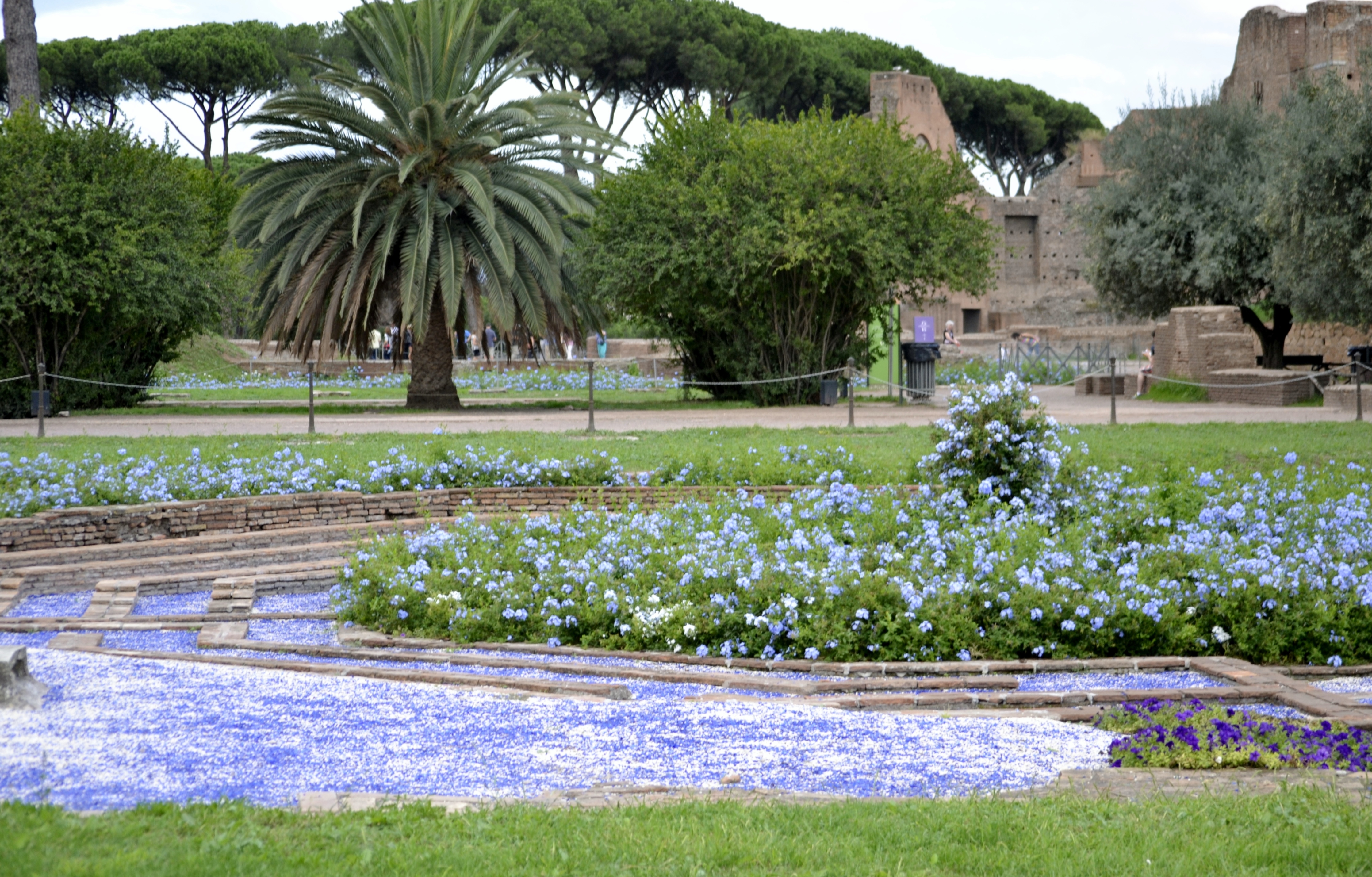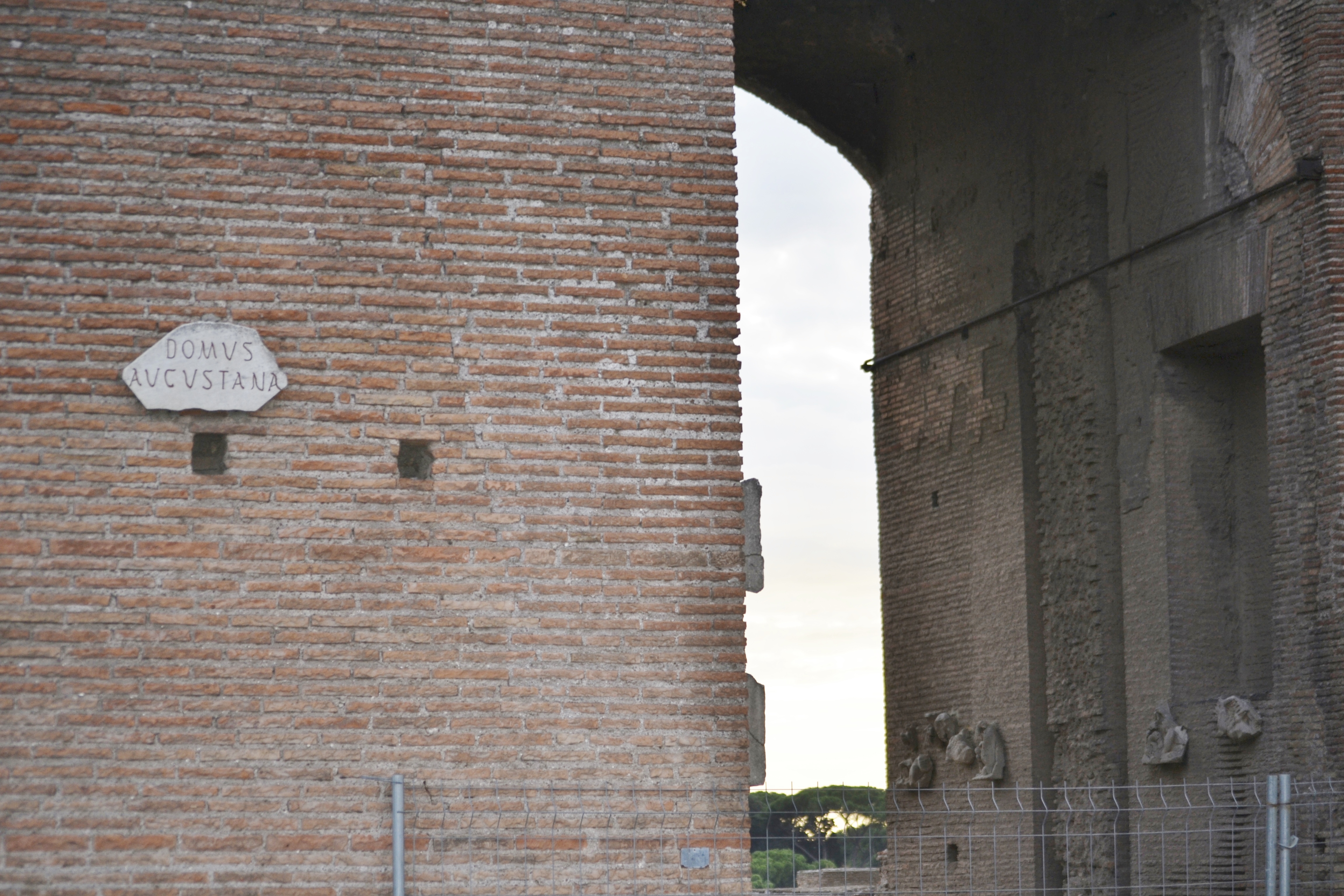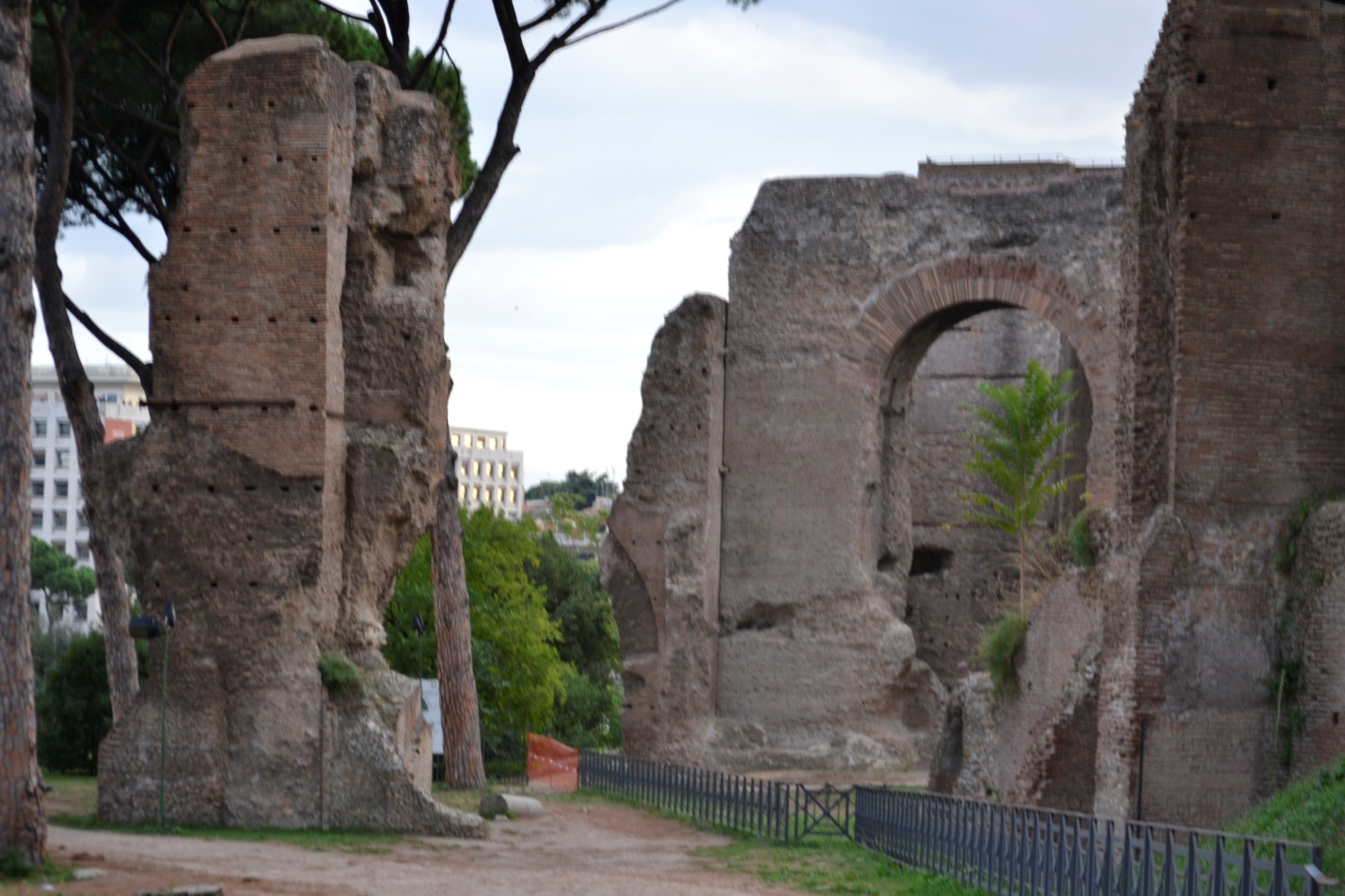The story of Rome begins like this, with two little baby boys, Romulus and Remus. Left in the woods to be raised by the lupa (she-wolf) in a nearby cave, the twins would grow up to be shepherds. They eventually ventured out, seeking to start their own city, but when the boys could not agree where to build their settlement, they had an argument ending in Romulus killing his brother Remus. Romulus continued to develop his city on Palatine Hill and would one day be credited for the founding of Rome in the mid-8th century BC. What remains of the Iron Age hut-like homes, found by archaeologists in the 1940s, are displayed today on Palatine Hill .
While Rome remained a powerhouse of ruling Emperors, the view of Palatine Hill must have been spectacular looking up from the Circus Maximus, one of the largest stadiums in Rome. The Emperor Domitian built a grand palace on the Palatine, one of the seven hills of Rome. It is said that he could watch the horse and chariot races from his estate while 300,000 spectators filled the stands below. I couldn’t wait to enter these ancient ruins to explore the huts of Rome’s earliest inhabitants, to imagine a life of luxury in the palace of a historical emperor and to enjoy the view of the Circus Maximus from the hill.
The entrance to Palatine Hill is a short walk from the Flavian Amphitheater, most commonly referred to as The Colosseum. The dusty pathway led to a gated entry where the ticket agent handed me an audio headset and a map. I immediately noticed that I had the place all to myself to indulge in the peaceful, city escape for the next couple of hours. Eager to begin my exploration of the imperial complex, I took a left walking up a hill towards the aqueduct, one of Rome’s notable contributions to civil engineering.
South of the Via di San Gregorio (one of the entrances to the Palatine Hill), are the impressive remains of Domitian’s Aqua Claudia, designed to bring water up to the Palatine Hill from water sources below. Located on the eastern edge of the hill are additional remains of Domitian’s Aqueduct.
During the Flavian dynasty, Emperor Domitian built the Imperial Palace where he would reign from 81 -96 AD. His estate, consisting of two parts, included the Domus Augustana where Domitian and his family would enjoy some private time. The public area, known as the Domus Flavia (House of Flavia) is where the emperor would greet guests and conduct business. According to some sources, Emperor Domitian installed mirrors in his throne room to watch for approaching enemies. The 150,000 square foot Imperial Palace would remain the center of Roman rule for over 300 years.
An extension of the Palace, which included the Terme Severiane (Baths of Septimus Severus) were built by Septimus Severus, who reigned over the Roman Empire from 193 – 211 AD. Additional archways and high ceilings were added to a section of the Flavian Palace, the Severan complex of the Domus Augustana.
The grandiose remains of this palatial estate prove the extravagance of Roman architecture. Roman rulers spared no expense when it came to the expansions of their palaces. Using the spoils they collected from their battles, each improvement was more luxurious than the one before.
The gardens of Palatine Hill are located in the Imperial Palace’s Peristilio or main courtyard. Shaped as an octagon, a sunken fountain of the Domus Flavia was one of the most popular of spaces of the royal family. The blue, white and purple wildflowers have since replaced the running water, but it was here I saw my first glimpse of wildlife, a little bunny lunching among the blooms. 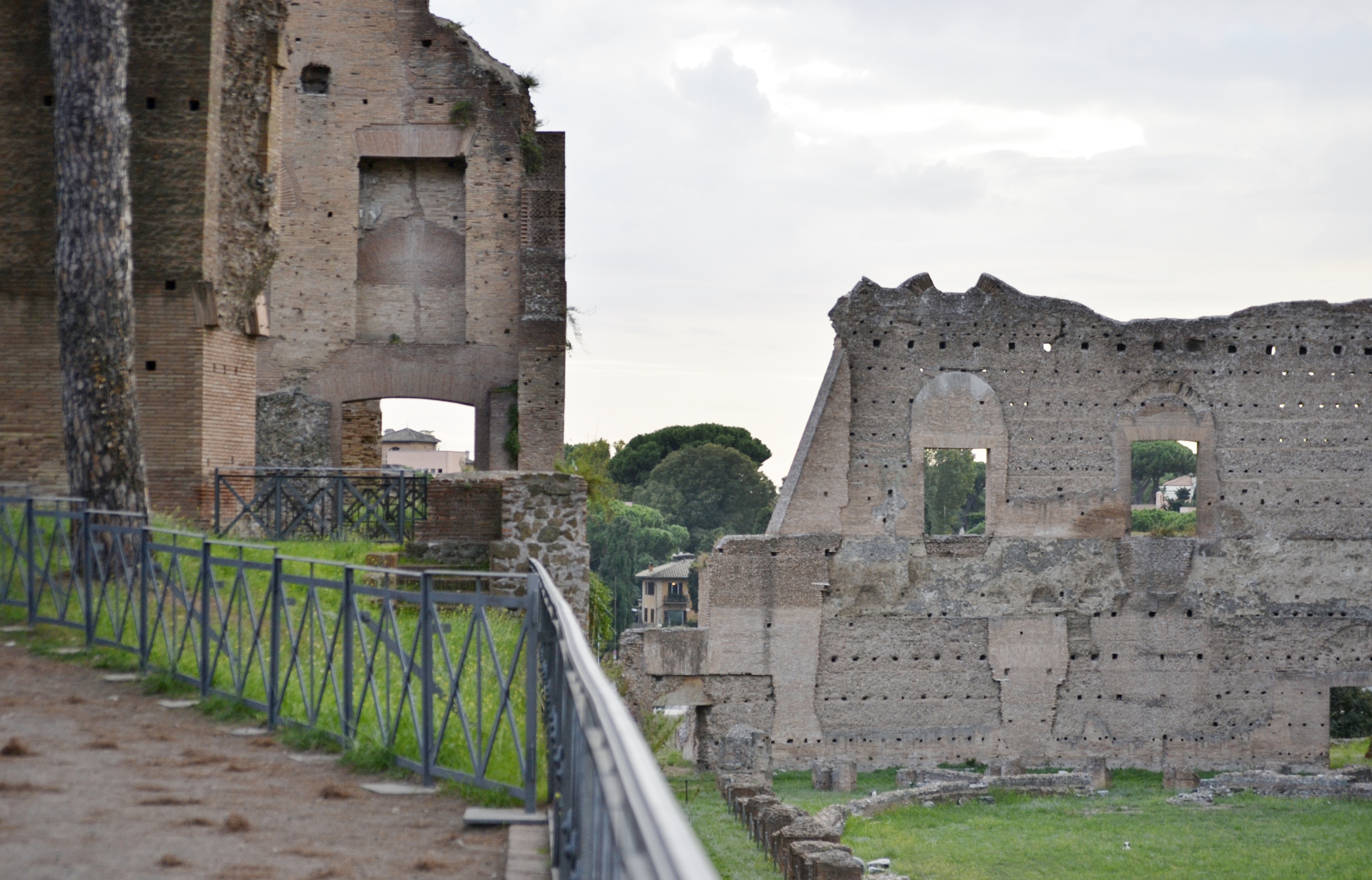
To the right on the lower level of the estate was Domitian’s Hippodrome located at the Domus Augustana Imperial Palace on Palatine Hill. Hippodromes were primarily built for horse racing, but archaeologists claim that the circular track (about 500 feet long), because of its small size, was most likely utilized for foot races. Changing rooms and an arcade for shade was added much later.
Further below, there was the cryptoporticus (tunnel) that runs beneath the Palatine Hill, discovered by archaeologists in 2008. Caligula was assassinated here at the age of 28, where he was stabbed up to 30 times, resembling that of the death of Julius Caesar. Caligula’s uncle, Claudius would take his place in succession to the throne.
The “Domus Augustana” were the private quarters of the emperor, built by Domitian. Named in honor of the Emperor Augustus, the structure was first built of brick and an additional layer of plaster or marble was added to cover the brick. The marble was secured to the walls using fasteners while the plaster was painted with frescoes. Considered one one of the more well-preserved sites on Palatine Hill, I was intrigued by the tight brick and mortar work and the height of these walls. Recesses in the walls displayed statues of the gods or busts of the family’s ancestors.
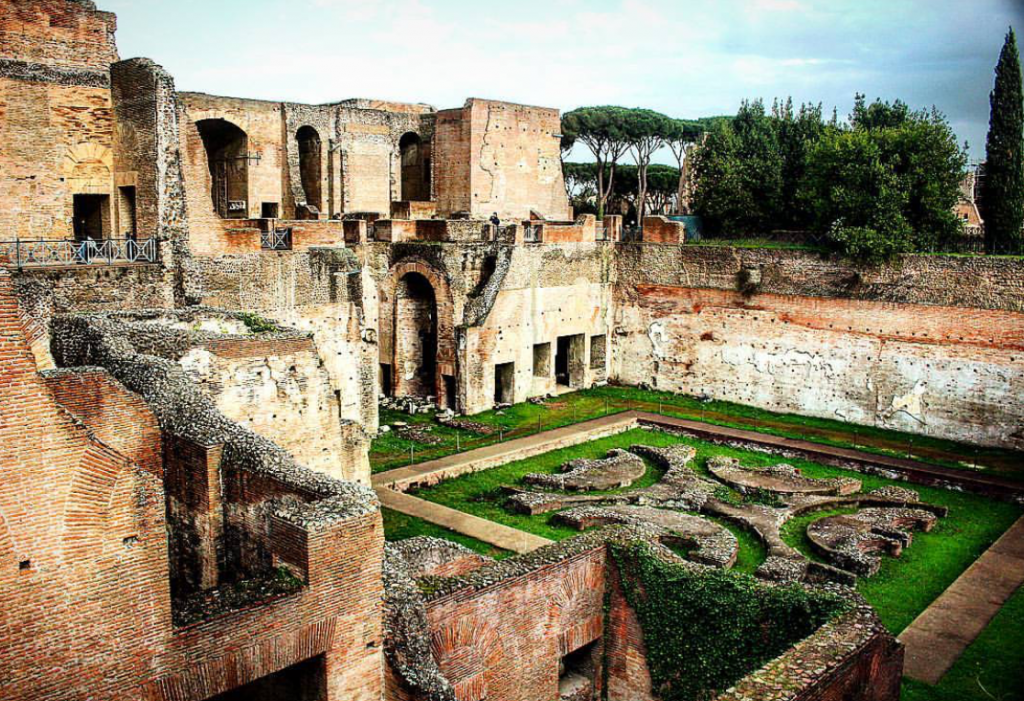
Behind the museum on the south side of the property is a beautiful garden, the remains of a large fountain. On the lower level, surrounding the open-air water feature was the ancient Triclinium, where the family would gather to eat their meals.
The Romans loved a day at the races and the Circus Maximus hosted, on average, 12 races per day. They bet on one of their favorite four teams – Blues, Greens, Red or White and were insanely devoted to their chosen charioteers. The horse track at the Circus Maximus measured 1300 feet long and close to a quarter of a million Romans would take their seats in the wooden bleachers. The races were short (about three and a half miles long) and dangerous with chariot collisions and overturned vehicles, resulting in the death of many. For over a thousand years, charioteers raced on this track.
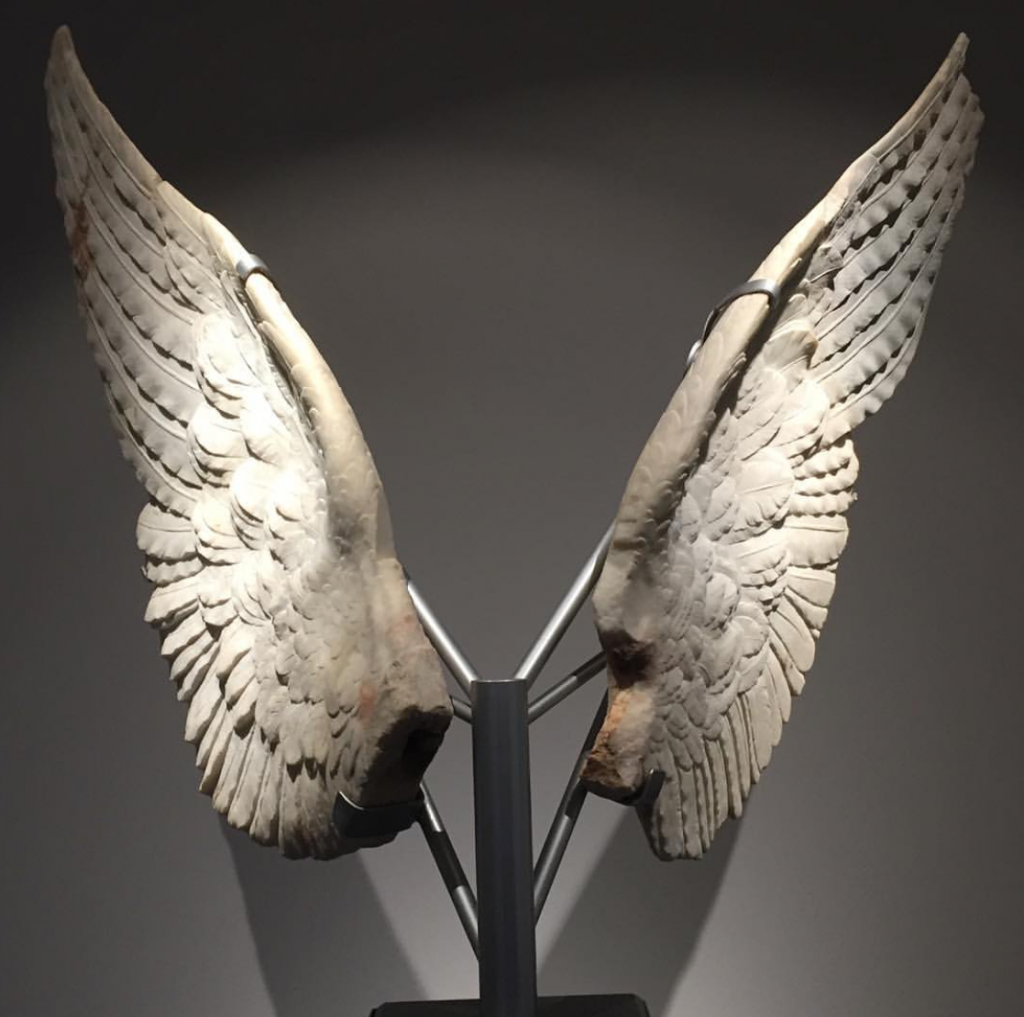
The Museo Palatino documents the history of Palatine hill from its humble beginnings. Starting at the lower level, there was a miniature replica of the Huts of Romulus (aka the Village of Germanicus), the original settlement of Rome. Computer displays recreate the extravagance of Palatine Hill and how it would have appeared during the reign of its Caesars and Emperors.
After exploring the frescoes and statues on the first floor, I accessed the second level from a set of stairs outside. A large statue of the Magna Mater, sitting on her throne was at the far end of the hall. Gorgeous frescoes and exquisite statues were displayed in the Augustus Room, where a gorgeous set of wings from a statue of Victory remained in pristine condition.
I would have overlooked the Throne Room (Aula Regia), had I not noticed a brick stump with a plaque marking the spot. A small white stone marks the location of one of the most powerful seats in world history. From here, the emperor made decisions that affected over 50 million people in his empire.
Roman dining practices for the wealthy were an art in themselves. Instead of sitting up at a table, they reclined on a couch in the triclinium, or dining room, where slaves would deliver the finest foods and wines to the emperor, his family and guests. They were entertained by exotic dancers and musicians, slaves from the countries they had conquered, amidst luxurious statues, frescoes and the nearby nymphaeum (fountain).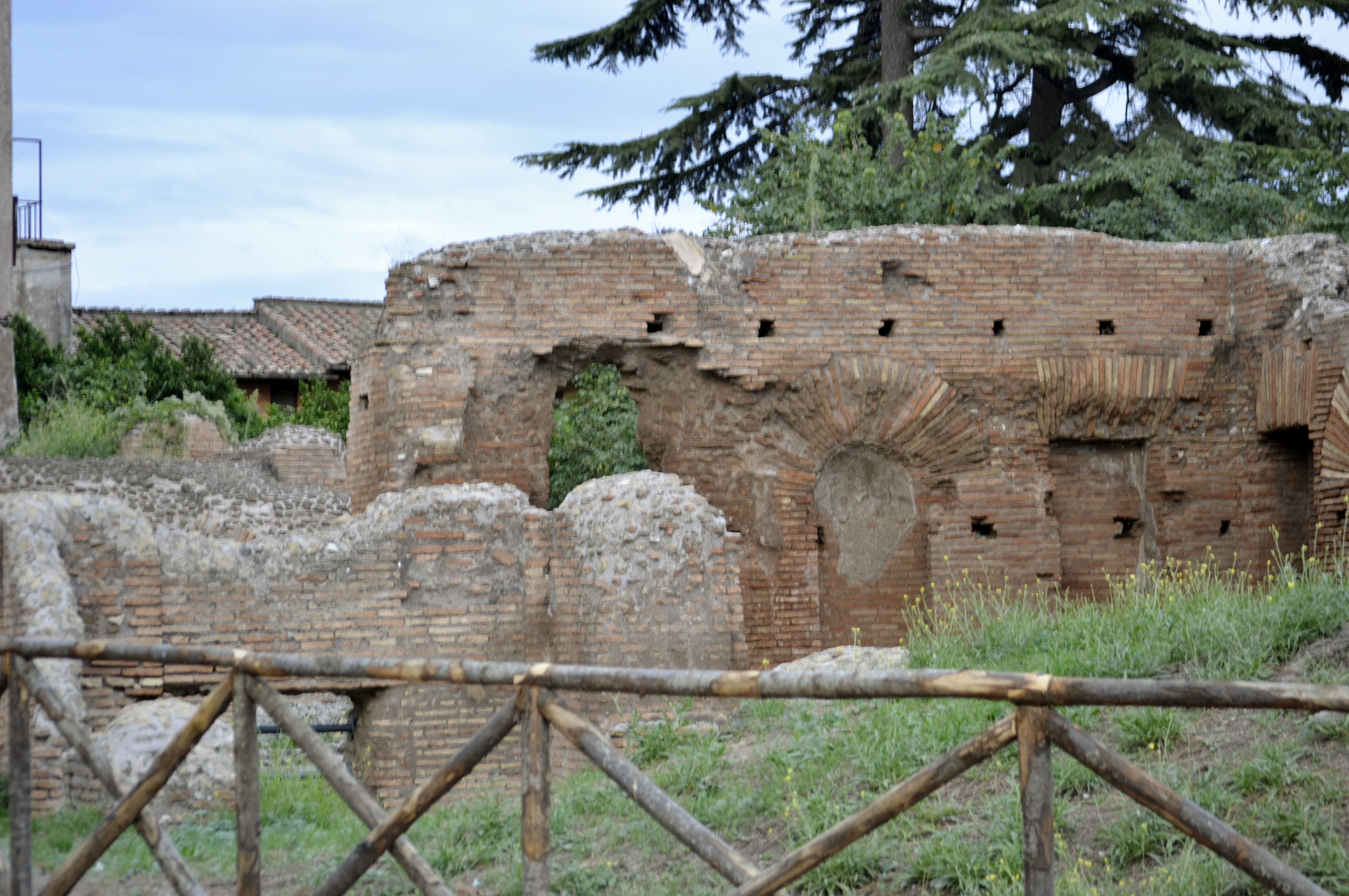
The Romans were notorious for their ability to build advanced water systems to collect and channel water. Remains of these amazing aqueducts can be seen all over Europe, Asia and Africa which were at one time a part of the Roman Empire. Once the water reached the Palatine Hill, it was kept in cisterns, tanks that stored water for future use. The Palatine Hill’s beautiful Nymphaem (fountain) and Roman baths relied heavily on the elaborate water systems of the city.

There are impressive ruins on Palatine Hill that date back to 1000 years BC. Looking out on the simple yet large in space, I wondered what purpose they fulfilled. When I think about the needs of civilization so long ago, were these structures homes or maybe stables to protect their livestock? I imagine even the earliest of structures were extravagant or remodeled to gratify the needs of the emperor.
One of my favorite exhibits at Palatine Hill includes the Casa di Livia and the Casa di Augusto (House of Livia and House of Augustus), the Cryptoporticus and the Huts of Romulus. Because there is generally a wait time for entrance into the House of Augustus, I decided to start here since during my last experience, I had waited only thirty minutes.

Entering the House of Augustus, I browsed through Octavius’s modest home, the three beautifully restored rooms and their vibrant frescoes. Octavius was known for his modesty and a much simpler lifestyle than most rulers which is evident in the wall paintings of his home. Instead of elaborate murals of the gods the artistry conveyed imitation columns, arches and windows that looked out onto imaginary landscapes.
Departing the House of Augustus, I lucked out to find an English tour taking place in about five minutes. Our tour guide mentioned it was our lucky day as they had just completed additional excavations of the site.
When Octavius Augustus married his second wife Livia, she was his next door neighbor, so they combined their homes. With Livia by his side, he ruled Rome for 45 years, restoring the Forum and building new structures throughout the city. The House of Livia is much smaller than the House of Augustus, but the frescoes are much more feminine. Livia was considered the model Roman wife and did not flaunt their wealth with fancy clothes or jewels. While Octavius was out conquering the world, she was making his togas and tending to her family. Even after his death, she was instrumental in the rule of Rome.
I had access to the formal entrance hall or the rectangular atrium, which opened up into four rooms with mosaic floors and gorgeously preserved frescoes. Towards the back of the home is the tablinum, the room where guests were received where we find the most preserved artistry. The House of Livia’s frescoes include scenic depictions of the gods and the mythical stories for which they were known. A scene that takes up three of the walls in the tablinum shows the god Mercury setting out to kill Argus the giant so that Mercury can kidnap the nymph to allow the god Jupiter to ravish her. Additional paintings in the niche off to the right of the tablinum is a landscape scene of a columned porch with beautiful gardlands, while the left alcove is Pompeiian in its style. To the right of the atrium is the triclinium (the dining room), and a set of stairs that runs between these two rooms that leads to the upper floor of bedrooms and service rooms.
The Palazzo Massimo alle Terme houses an additional, preserved frescoe from the House of Livia. Located on the top floor of the museum, this mural includes a landscape of trees, birds and flowers.

But it is the simplest archaeological treasures that I find so fascinating, such as the water pipes found in Livia’s home with her name inscribed upon them.
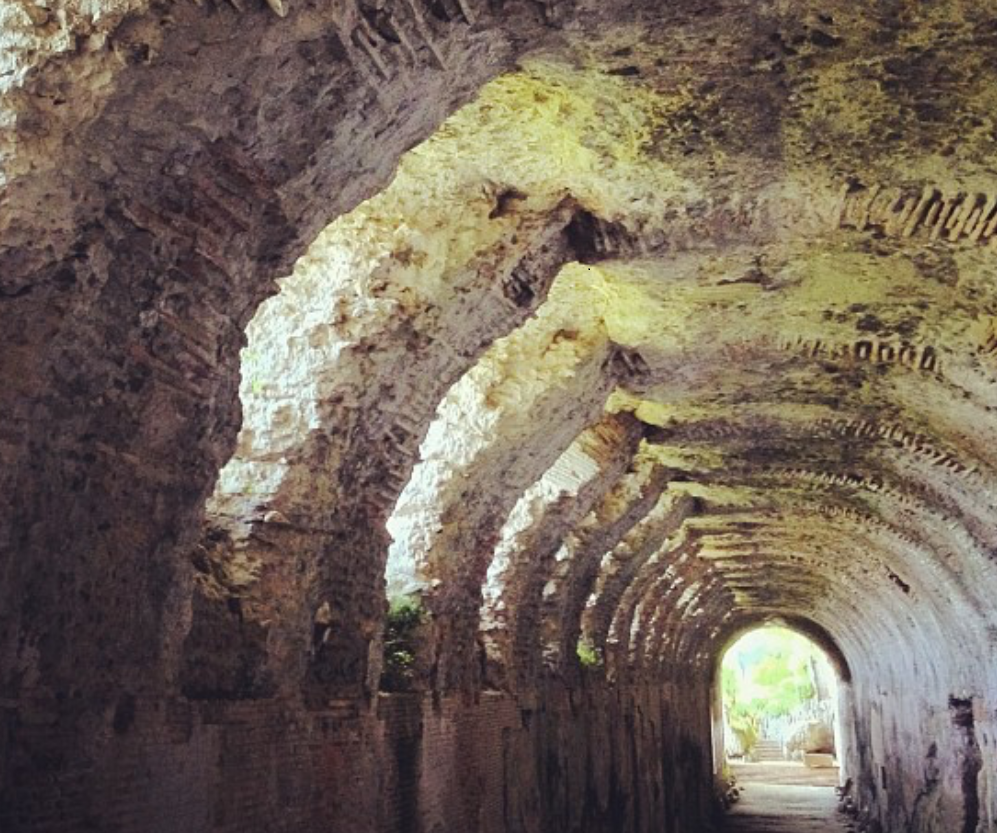
Learning that the Cryptoporticus was a secret passageway for the emperors to reach the Forum from the Palatine Hill, we were quite surprised that it was only 400 feet long. The covered corridor was once elaborately decorated with frescoes along the tunnel walls, but evidence of these paintings hardly remain. Resources link Domitian, Nero, Tiberius and Caligula to the underground channel, with the latter having been assassinated here.
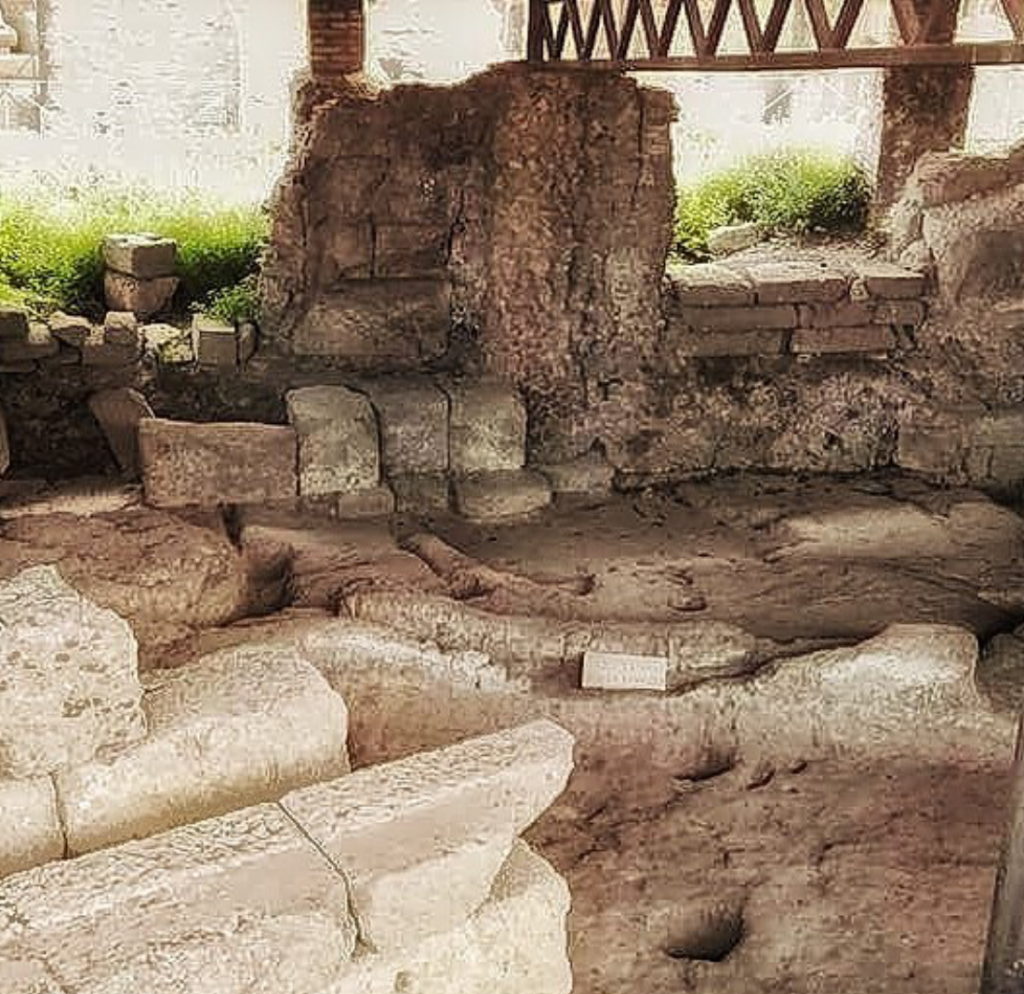
Protected by a metal awning, the city of Germanicus, Rome’s early settlement is said to have been born in this very spot. Of course, the story of Rome’s humble beginnings is legendary and when archaeologists uncovered these huts, it only seemed to solidify the story of Romulus and Remus. As we looked down into the location that was considered Rome’s first early civilization, Germanicus, we tried to imagine how these blocks of stone would have looked back in the 8th century BC, known today as the Huts of Romulus (Capanne Romulee). Long rectangular and curved shapes are the partial outlines of huts, while the holes would have held wooden posts supporting the round thatched shacks.
Even more fascinating is that archaeologists, in 2007, uncovered a cave that was decorated with seashells, colored marble and a wolf painting, thought to have been that of the Lupercale. Unfortunately, this cave is not open to the public and historians believe that it may have been a temple to the water nymphs, not the home cave of the founders of Rome.
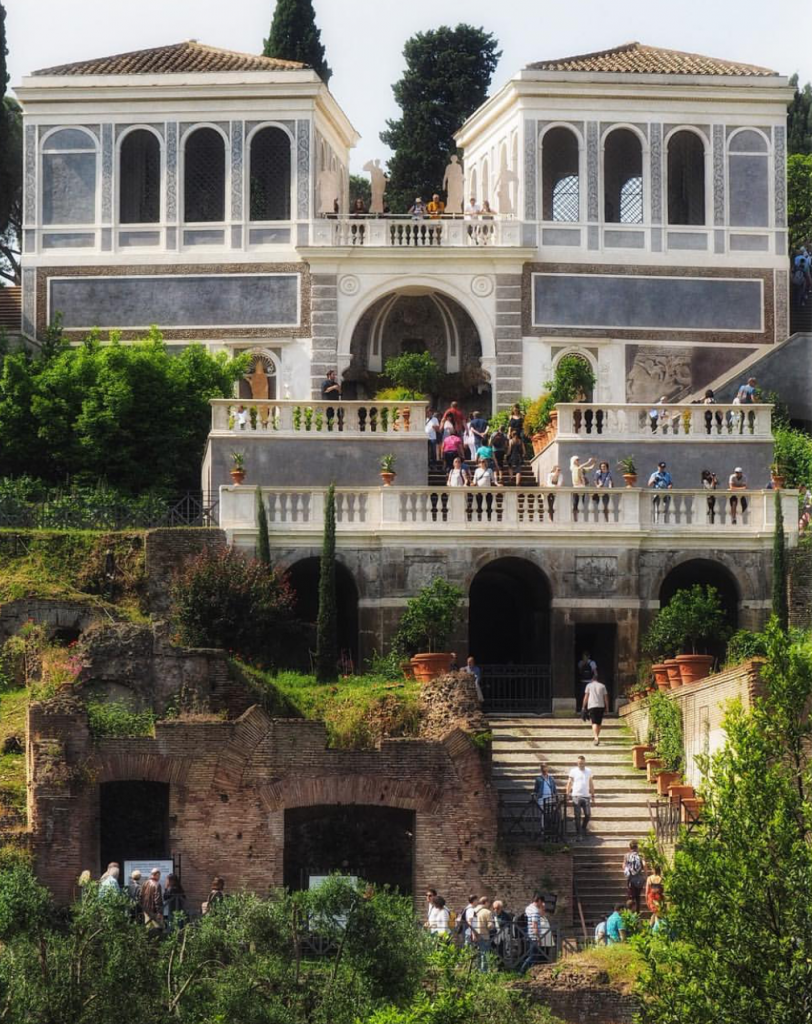
My final stop on Palatine Hill was to admire the Orti Farnesiani (Farnese Gardens) and the spectacular view of Palatine Hill. Much of the Palatine was reworked in the Renaissance when it was bought by Cardinal Alessandro Farnese and turned into an exceptional garden with exotic plants, fountains, pavillions and an underground cavern. The Farnese family built the first botanical gardens on Palatine Hill long after Domitian’s reign, which included an aviary, a nymphaeum (fountain) and various works of art.
Impressive scenery from the Palatine Hill includes panoramic views of the Roman Forum and the Colosseum, while on the other side of the complex, a scenic outlook of the Circus Maximus. Exiting the Palatine Hill, I enjoyed the shelter of the umbrella pines, imagined the earliest civilizations of Rome and dreamed of the glamorous life of the emperors.
How would you imagine your life living in Rome at the time of the Caesars? I would love to hear your thoughts if you would kindly leave a message in the comments section below!
What to See and What to Do:
Purchase a Ticket for the Hop On/Hop Off Bus
Palatine Hill
Via della Salara Vecchia, 5/6
Via di San Gregorio
Via Sacra, Roma, Italia
Telephone: +39 06 3996 7700
- Admission Fee: 12 Euros for the combination ticket which includes the Roman Forum, Colosseum and Palatine Hill. By purchasing the Roma pass, these three venues are included in the ticket, valid for a period of two days. Individual tickets for each attraction are not available. One visit to each attraction per ticket per person is permitted. The venue is free on the first Sunday of the month, but can be very crowded. The Museo Palatino (Palatine Museum) is the tall grey building located between the Domus Flavia and Domus Augustana. included in the ticket and it is open from 8:30 AM until one hour before sunset. The telephone number for the Palatine Museum is +39 06 3996 7700 and the website is www.pierreci.it. In addition, there is the House of Augustus which is open each day from 8:30 Am to 1:20 PM with the exception of Tuesday and Friday. The House of Livia, which may or may not be open, but if it is, there are free 20-minute tours of the home provided in both English and Italian.
- Bus/Metro Stop: Buses 51, 85, 87, 118, 186 and 810; Metro: Colosseo – B Line (blue)
- Hours: Open daily from 8:30 until one hour before sunset (check at the ticket counter to confirm closing time); tickets can be purchased up to one hour before closing.
- Entrance Locations: The entrance into Palatine Hill is most easily accessible from the Forum’s Arch of Titus, located near the Colosseo Metro stop. There is also an entrance on Via Di San Gregoria, which is further away, but may be less crowed.
- Guided Tours and Informational Booklets: Check out the ticket booth for guided tours which are provided in both English and Italian. Audioguides are available at the entrance of Palatine Hill for 5 Euros.
- Scenic View: There are gorgeous views of both the Circus Maximus and Roman Forum from Palatine Hill.
- Length of the Tour: Allow 2 and a half hours to explore the Palatine Hill (if your visit includes the museums)
- Tips for Your Visit: Wear comfortable shoes for walking. Restrooms are located at the entrance to Palatine Hill, near the museum and close to the Farnese Gardens. It is best to buy the combination ticket here at Palatine Hill to avoid the long lines at the Colosseum.
Where to Stay:
Courtyard Rome Central Park
Via Giuseppe Mosacti 7
Rome 01168 Italy
Telephone: +39 06 355741
Where to Eat:
Enoteca Cavour 333
Via Cavour 333
00193, Rome Italy
Telephone: +39 06 678 5496
Enoteca Cavour 333 is a wine bar located in the Monti district in the heart of Rome. Located between the Roman Forum and the Basilica of Santa Maria Maggiore, this restaurant offers over 1000 bottles of wine and an extensive wine list.
We were so excited to find an enoteca (wine bar) so close to Palatine Hill and made an afternoon out of it. For lunch, I ordered the Rolls of Culatello (cured for at least 10 months ) from Sauris with Honey Tarragon Sauce, while David decided upon the Pistachio Crusted Pork Tenderloin. Both were simply delicious with a bottle of Vigna Flaminio, Brindisi Riserva 2010. We purchased a 2007 Giuseppe Rinaldo Barolo to enjoy for later.
The restaurant is open daily from 12:30PM to 2:45PM. Their evening hours are Monday through Thursday, 6PM to 11PM, on Friday and Saturday from 6PM to Midnight and on Sunday from 7PM to 11PM. Note that in the month of August, the restaurant is closed on Sundays.
Many thanks for reading about my stroll through Palatine Hill! Wishing you many Happy Travels!
What to Eat:
- Artichokes: steamed or fried
- Cacio e Pepe: Cacio is a type of cheese from Rome’s countryside made from sheep’s milk. The dish is served over pasta and seasoned by black pepper.
- Carbonara: creamy white pasta served with pancetta and noodles
- Gelato: You have not had gelato until you have had it in Rome!
- Maritozzi is a popular breakfast pastry with chocolate chips served with espresso. Some maritozzi are filled with cream as well.
- Pecorino Romano cheese
- Pizza al Taglio is Rome’s answer to pizza with red sauce, meats, vegetables and cheeses. I also love the Italian margarita pizza with red sauce, mozzarella cheese and topped with basil.
- Porcetta: Pork wrapped around herbs and roasted on a spit
- Saltimbocca is a dish made with veal and sage wrapped in prosciutto, cooked in white wine and butter.
- Suppli is considered an Italian snack made of rice and meat with tomato sauce and filled with mozzarella cheese and then deep-fried. It reminds me of arancini in the US.
Where to Drink:
Il Goccetto (for wine)
Via dei Banchi Vecchi, 14
00186, Roma RM, Italy
Telephone: +39 06 9944 8583
Terrazza Borromini
Via di Santa Maria dell’Anima, 30A
00186 Roma RM, Italy
Telephone: +39 06 6821 5459
While the drinks are pricey, it will be worth the cost for the fabulous views.
What to Read:
- Imperium, by Robert Harris
- Roma, by Steven Saylor
- SPQR, by Mary Beard
- The Twelve Caesars, by Robert Grave
Photo Guide for Rome:
- Campo de’ Fiori for photos of the market
- The Colosseum
- Monti for upscale boutiques, restaurants and vintage stores
- The Pincio Terrace overlooking Piazza del Popolo in northern Rome
- The top of St. Peter’s Basilica
- Trastevere neighborhood for scenic alleyways, artisan workshops, the piazza at sunset, and tiny boutiques. Find the corner of Vicolo delle Torro off of Via della Lungaretta for photo-worthy pics.
- Trevi Fountain

An extension of Domitian’s Aqueduct
An umbrella pine shading the ruins on Palatine Hill
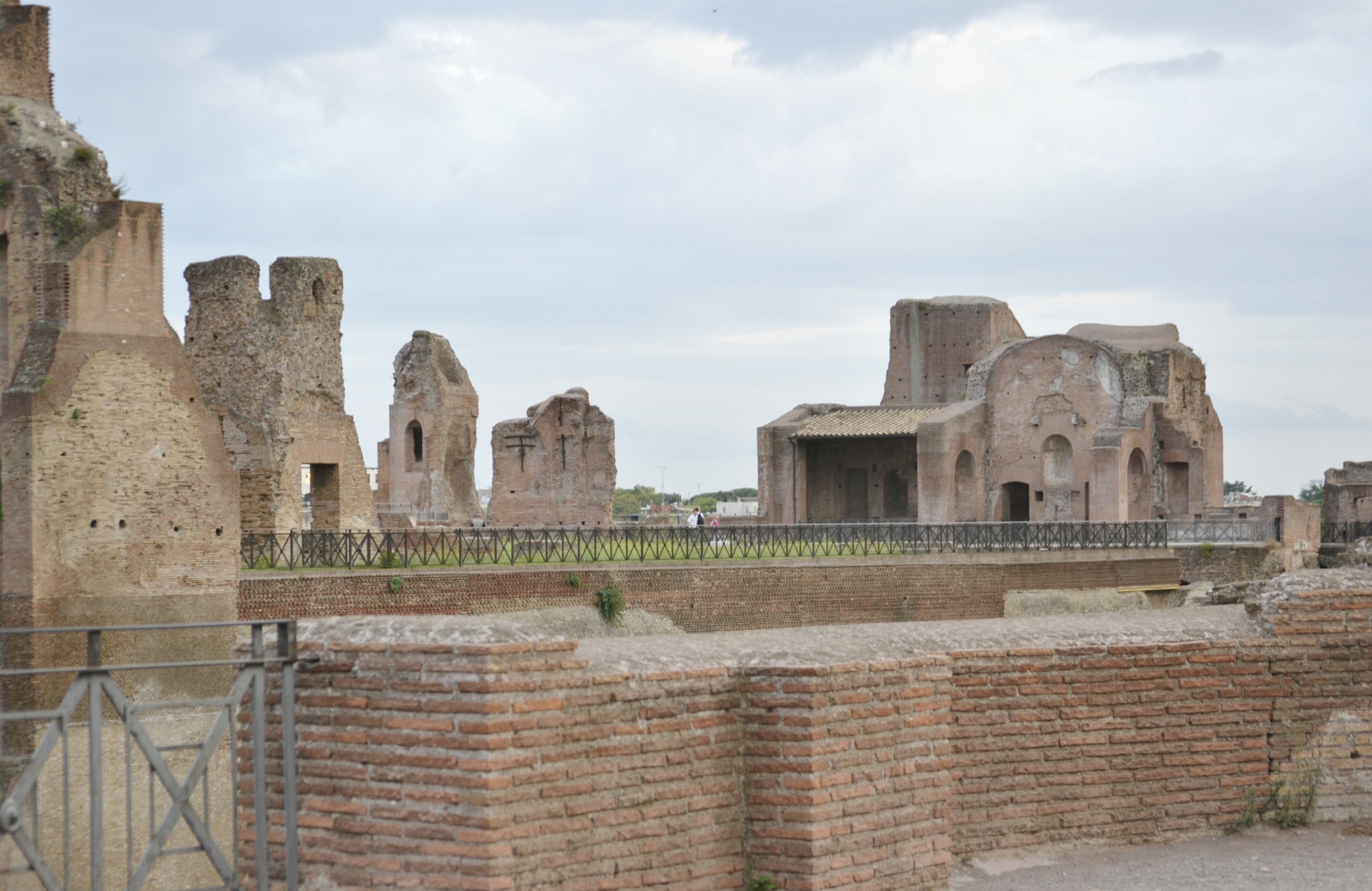
Ruins Dating Back to 1000 BC


